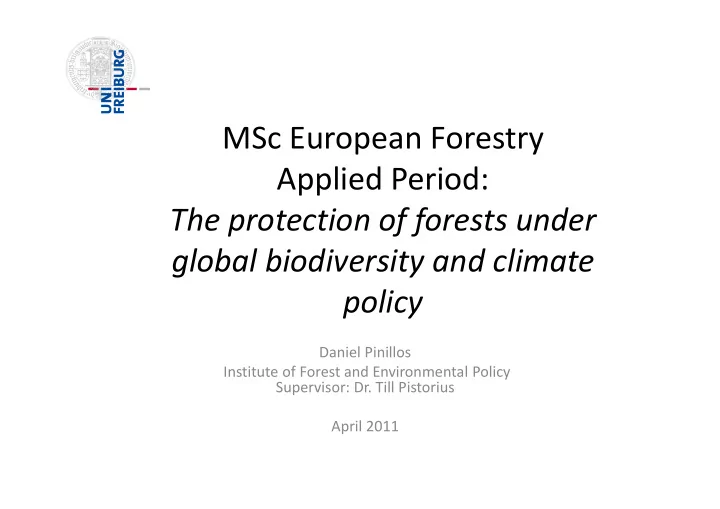

MSc European Forestry Applied Period: The protection of forests under global biodiversity and climate global biodiversity and climate policy Daniel Pinillos Institute of Forest and Environmental Policy Supervisor: Dr. Till Pistorius April 2011
Description • Participation in the project: � The protection of forests under global biodiversity and climate policy (Sub project 1) biodiversity and climate policy (Sub project 1) • Task : � Case of study: Deforestation, biodiversity and REDD+ initiatives in Guatemala
Case of study: Guatemala Why is Guatemala relevant for biodiversity and REDD+? � One of the most extensive and diverse forest systems in Central America. � One of the most extensive and diverse forest systems in Central America. In 2010 forest cover > 3,657,000 ha (44% primary forest) In 2010 forest cover > 3,657,000 ha (44% primary forest) � Home to 1,246 known species of amphibians, birds, mammals, and reptiles, and 8,681 species of plants, of which 13.5% are endemic � Current annual deforestation ~ 73,000 ha/year (1.5% per year in 2009) (www.rainforests.mongabay.com) )
Case of study: Guatemala � Initial premises (Sticking to the project) � Literature review (official/published documents) � Interviews with key national actors � Analysis � Discussion and Conclusions
Premise 1 • “REDD+ attributes a value to forest ecosystems based on just one of the many ecosystem services they provide - the quantifiable storage of carbon they provide - the quantifiable storage of carbon and the ability to sequester CO 2 . ” (Pistorius et al. 2010)
Premise 2 • “Biodiversity with all its components is crucial in this context because it is the fundamental basis of all ecosystems for adapting to climatic basis of all ecosystems for adapting to climatic changes.” (Pistorius et al. 2010)
Literature review � Historical background of deforestation � Current deforestation rates and figures � Current deforestation rates and figures � Driving forces of deforestation
Historical background Four space-time phases of deforestation 1. Mayas in the lowlands of the north 2. Mountainous regions during the Colonial epoch 3. Pacific Coast and agro- exportations 4. Agrarian Conflicts and back to the lowlands of the north (Cabrera 1996)
Current deforestation figures Forest cover change during the Deforestation rates from 1950 to 1950-2005 period 2005 (URL ,IARNA 2009 )
2037 Scenario in Petén (AGEXPORT 2011 )
Driving forces of deforestation � Proximate forces: – Human activities or immediate actions at a local level � Underlying driving forces: � Underlying driving forces: – Social processes that underpin the proximate causes and can operate at the local level or have an indirect impact at the national or global level (Geist & Lambin, 2002)
Proximate forces in Guatemala � Land use change to agriculture � Drug traffic and cattle ranching in remote areas � Mining & oil exploitation � Illegal logging and wood consumption � Forest fires
Underlying forces in Guatemala � Agrarian and socioeconomic problematic � Protected areas and weak forest governance � Protected areas and weak forest governance � Historical absence of forestry culture
REDD Pilot projects � Rainforest Alliance and FSC certified concessions : GuateCarbon Project � Defensores De La Naturaleza: Sierra Lacandón and Sierra de las Sierra Lacandón and Sierra de las Minas � FUNDALACHÚA: Laguna de Lachúa � San José and San Francisco Municipality and Global Carbon Group AGEXPORT 2011
I Interviews to national experts and key actors � Dr. César Azurdia : CONAP, Coordinator of The Genetic Resources Management Department � Ing. Andrea Juárez and Ing. Mario Rojas :Defensores de la Naturaleza, REDD project in Sierra Lacandón Naturaleza, REDD project in Sierra Lacandón � Dr. Elke Mannigel: OroVerde - Die Tropenwaldstiftung Internationale Projektkoordination � Vivián Villegas Rivas : AGEXPORT, Guatemalan Exporters´Association
Questionnaire 1. Which components of biodiversity are especially valuable and should have priority for conservation on the national/subnational level? 2. Which components of biodiversity are likely to be affected by REDD+? 3. What are the necessary preconditions for monitoring the ecological impacts of REDD+? (Entenmann 2011)
Additional questions � Which of the REDD+ activities has priority when implementing the project? � What is the definition of forest used in the conception and design of a REDD+ project? � Are the current forest incentives applicable in the design of a REDD+ national strategy?
Ongoing work ………………….. � Analysis and wrapping up: � Discussion and Conclusions
References � Cabrera (1996): Síntesis histórica de la deforestación en Guatemala. Facultad Latinoamericana de Ciencias Sociales. Guatemala. � Entenmann S (2011): REDD+ as a mechanism for forest conservation in developing countries: evaluation of national strategies and REDD+ pilot projects regarding ecological conservation targets. PhD thesis progress document, University of Freiburg Germany. � � Geist H, Lambin E (2002): Proximate Causes and Underlying Driving Forces of Tropical Geist H, Lambin E (2002): Proximate Causes and Underlying Driving Forces of Tropical Deforestation. ProQuest Biology Vol 52 No.2 Journals pg.143 . Mongabay (2011): Guatemala Forest Information and Data. Accessed: March 29 th 2011 � [http://rainforests.mongabay.com/20guatemala.html] � Pistorius T, Schmitt CB, Benick D and Entenmann S (2010): Greening REDD+: Challenges and opportunities for forest biodiversity conservation. Policy Paper, University of Freiburg, Germany. � URL, IARNA. (2009): Perfil Ambiental de Guatemala 2008-2009: las senales ambientales críticas y su relación con el desarollo. Guatemala.
Additional activities • Present in the WP2 Freiburg Meeting 28 th March 2011-30 th March 2011 • Purposes of the workshop: discussion on theoretical approaches, methods and data, agree on a common framework for papers integration
Thank you for your attention Questions?
Recommend
More recommend